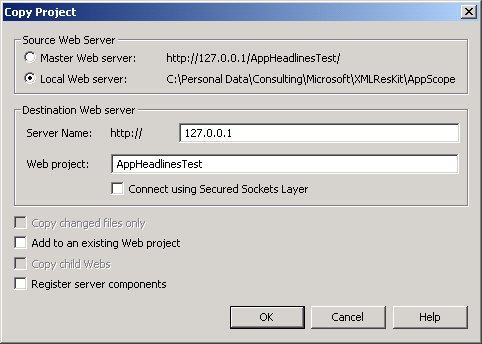Application-Scoped Headline Manager
Aaron Skonnard
Developmentor
![]() Download the sample: AppScopeObject.exe
Download the sample: AppScopeObject.exe
Requirements
In order to use this sample, you first need to compile the AppHeadlines ActiveX DLL (see the AppHeadlines Visual C++ project for more details). Or you can simply register the AppHeadlines ActiveX DLL that came with the sample. Once the AppHeadlines DLL is registered on your machine, you're ready to use this sample IIS Application for testing.
After opening this project (AppHeadlinesTest), use Visual InterDev's Copy Web Application feature to copy the project to your master Web server. The sample application is configured to use your machine's local loopback address (http://127.0.0.1) for the master Web server. When you use the Copy Web Application dialog, make sure the settings look like this:

Once the Web application is successfully copied, you can run the project in both master and local mode.
Description
This sample demonstrates how to write an ASP application-scoped COM object that can manage global state (such as news headlines) using the Extensible Markup Language (XML). When the Web application starts, the AppHeadlines.HeadlineMgr component is created and the object reference is stored within the ASP Application object (see global.asa). The Web application starts as soon as you click on one of the links below to an ASP page.
The other ASP pages that make up the application (printall.asp, printbycategory.asp, etc.) simply retrieve the HeadlineMgr object reference from the Application object and call the appropriate methods to retrieve/update the application headlines. For example, printall.asp is as simple as this:
set obj = Application("objHeadlines")
Response.Write obj.PrintHeadlines 'prints all headlines in HTML
The HeadlineMgr object reference can be stored at application-scope because it aggregates the free-threaded marshaler (FTM). The FTM provides the marshaling necessary to let any IIS thread (ASP page) call into our object without a context switch. If you tried to write the code above with an object that doesn't support the FTM, you would get the following ASP error:
Application object, ASP 0197 (0x80004005)
Disallowed object use
Cannot add object with apartment model behavior to the application intrinsic object.
/AppHeadlinesTest/global.asa, line 24
ASP only allows apartment neutral objects to live at application and session scope. The HeadlineMgr component is indeed apartment neutral - therefore, any object references that it holds cannot be apartment relative either. Luckily, MSXML offers a DOMDocument coclass that also aggregates the FTM called DOMFreeThreadedDocument. By using this coclass, HeadlineMgr doesn't have to worry about using other mechanisms like the global interface table (GIT) to make internal DOM document object references apartment neutral.
Note: whether or not an object aggregates the FTM is an intimate implementation detail that you shouldn't get in the habit of making assumptions about. Because of this, your usually better off using the GIT for storing apartment neutral objrefs.
Most of the HeadlineMgr methods perform a simple XSL transformation on the XML headlines stored in memory and return the resulting HTML. Using this technology, clients never have to hit a database but they can still perform fairly sophisticated queries and filters by leveraging the richness of XML. For more information on the XML & XSL files being used in this example, see headlines.xml, headlines-all.xsl, and headlines-node.xsl.